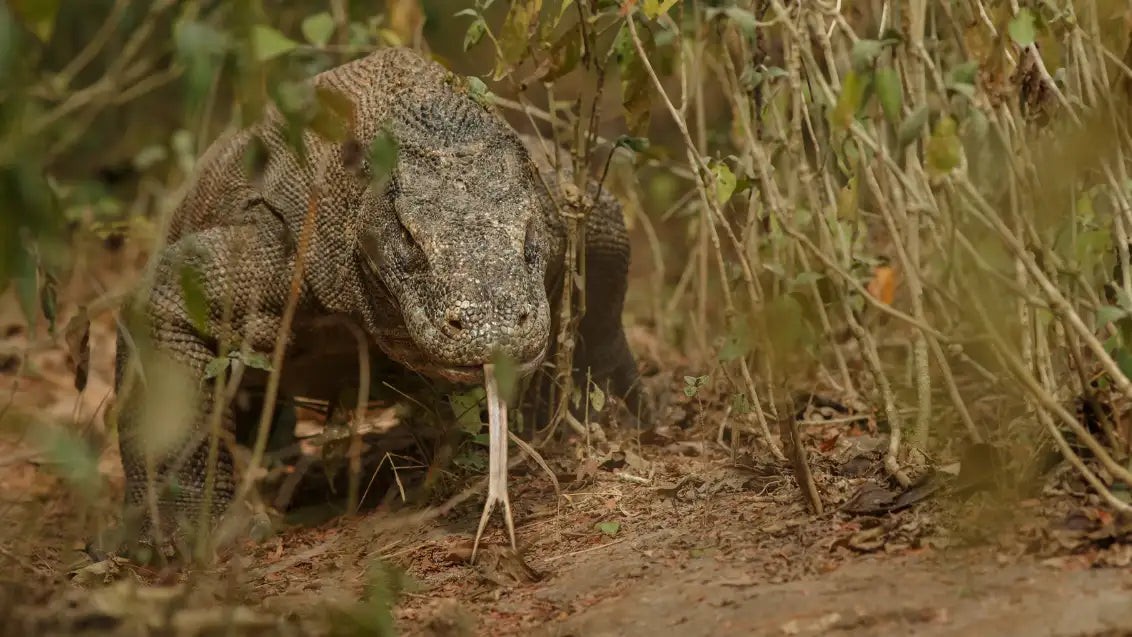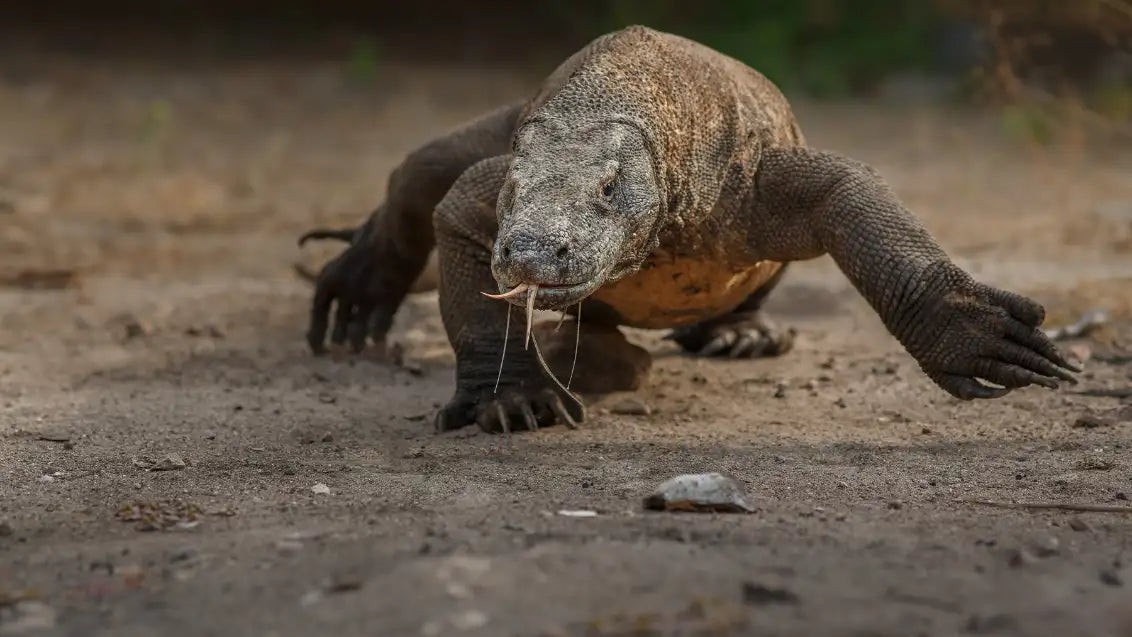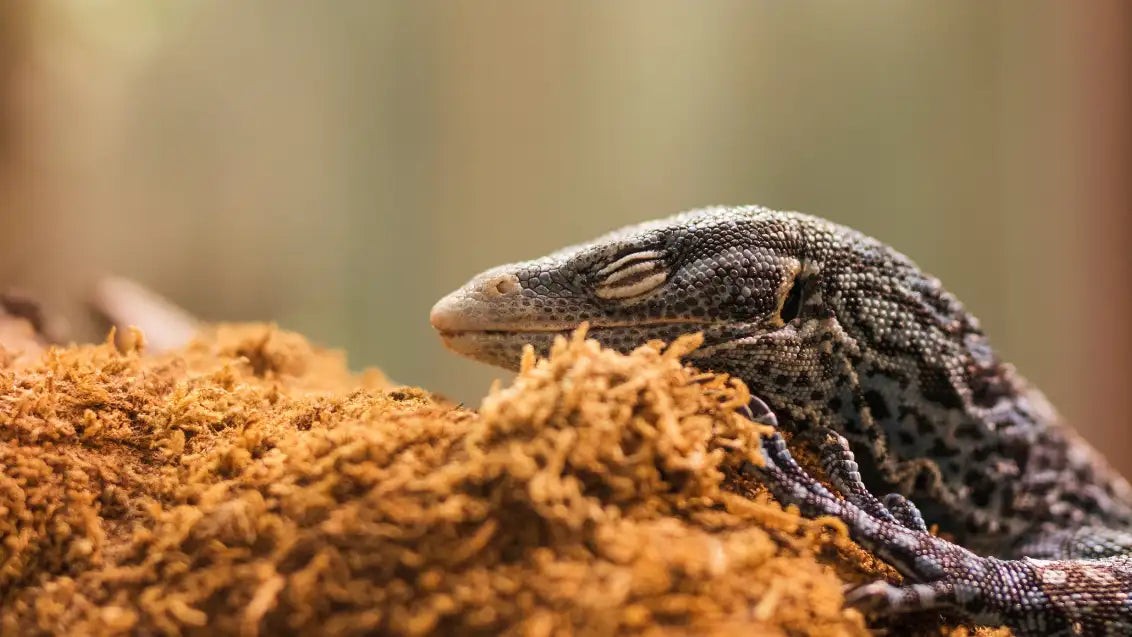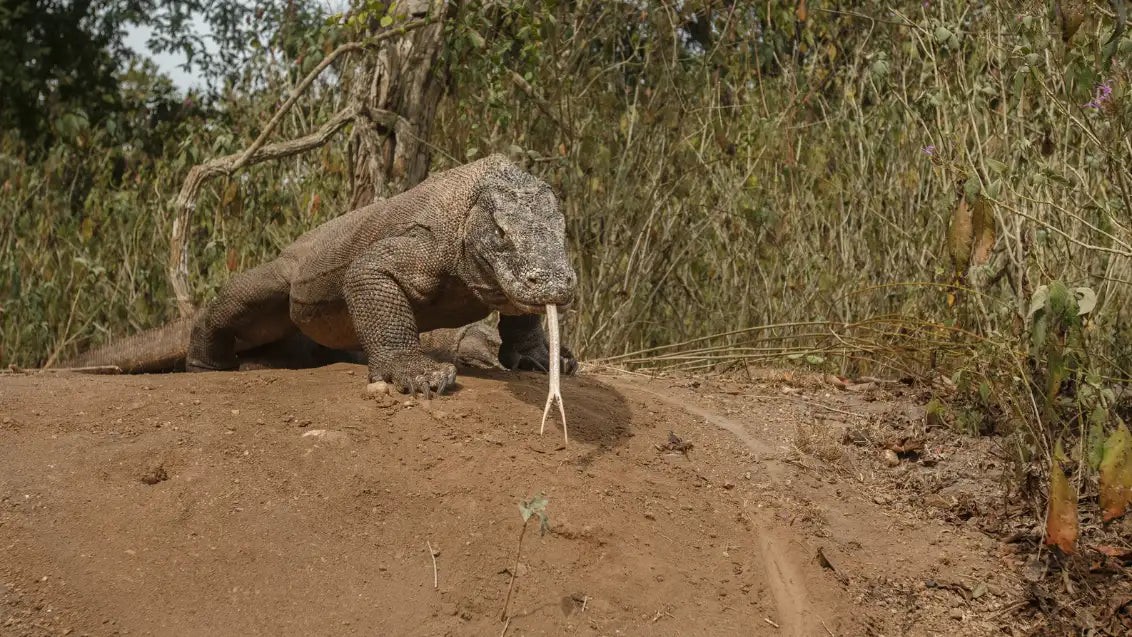Are you fascinated by Komodo dragons and considering one as a pet? The reality of “Can You Keep Komodo Dragons As Pets” is complex. PETS.EDU.VN explores the legal, ethical, and practical challenges of owning these magnificent creatures, offering insights into why they’re best admired in the wild. Discover responsible alternatives and gain a deeper appreciation for Komodo dragons, including conservation efforts, reptile care, and wildlife sanctuaries.
1. What Is a Komodo Dragon and Why Are They Fascinating?
The Komodo dragon ( Varanus komodoensis) is the world’s largest lizard, captivating people with its imposing size and ancient lineage. Reaching lengths of up to 10 feet and weighing as much as 150 pounds, these reptiles possess a powerful build, sharp claws, and serrated teeth, making them formidable predators. Their existence on a few Indonesian islands has intrigued scientists and animal enthusiasts for decades. But their exotic appeal often leads to the question: can these apex predators be kept as pets?
| Characteristic | Description |
|---|---|
| Scientific Name | Varanus komodoensis |
| Size | Up to 10 feet long |
| Weight | Up to 150 pounds |
| Key Features | Powerful build, sharp claws, serrated teeth |
| Natural Habitat | Indonesian Islands (Komodo, Rinca, Flores, Gili Motang, and Padar) |
| Conservation Status | Vulnerable |





Komodo dragons, known for their impressive size and powerful build, are captivating creatures found in the Indonesian islands.
2. Understanding the Natural Habitat and Behavior of Komodo Dragons
Before considering the possibility of owning a Komodo dragon, it’s essential to understand their natural habitat and behavior. These factors significantly influence their welfare and the feasibility of keeping them in captivity.
2.1. Natural Habitat
Komodo dragons inhabit the hot and dry savanna landscapes of a few Indonesian islands, including Komodo, Rinca, Flores, Gili Motang, and Padar. They thrive in open grasslands and forested areas where they can bask in the sun and hunt prey. The temperatures in their natural habitat range from 95°F to 110°F (35°C to 43°C), requiring specific environmental conditions to maintain their health and well-being.
2.2. Behavior in the Wild
Komodo dragons are primarily solitary creatures, interacting with each other mainly during mating season or when scavenging for food. They are ambush predators, relying on stealth and power to capture their prey. These reptiles are known for their territorial nature, often engaging in aggressive displays to defend their hunting grounds.
| Behavior | Description |
|---|---|
| Solitary Nature | Primarily solitary, except during mating and feeding |
| Hunting Style | Ambush predators, relying on stealth and power |
| Social Structure | Limited social interaction, mainly during mating and feeding |
| Reproduction | Lay eggs, with an incubation period of approximately 8 months |
Komodo dragons prefer hot and dry savanna landscapes, thriving in open grasslands and forested areas of the Indonesian islands.
3. What Self-Defense Mechanisms Do Komodo Dragons Possess?
Komodo dragons are equipped with a variety of self-defense mechanisms that make them formidable predators and challenging to handle. Understanding these features is crucial when considering the safety aspects of these animals.
3.1. Key Self-Defense Weapons
- Powerful Bite: Komodo dragons possess a powerful bite that can inflict deep wounds. Their saliva contains a complex cocktail of bacteria and venom, leading to severe infections and shock in their prey.
- Sharp Claws: Their sharp claws are used for slashing enemies and securing prey.
- Thick, Armored Scales: These scales provide a protective layer against attacks.
- Whipping Tail: The tail can be used to knock down prey or rivals.
- Speed: Komodo dragons can sprint up to 12 mph (20 km/h) in short bursts.
- Camouflage: Their coloration allows them to blend into their surroundings for stealth hunting.
- Aggressive Nature: They display aggressive behaviors as a deterrent through intimidation.
3.2. Implications for Pet Ownership
These self-defense mechanisms pose significant challenges for anyone considering keeping a Komodo dragon as a pet. The risk of serious injury from bites, scratches, or tail strikes is substantial, making them unsuitable for the average pet owner.
4. Exploring the Diet and Feeding Habits of Komodo Dragons
Understanding the diet and feeding habits of Komodo dragons is crucial when evaluating their suitability as pets. Their voracious appetite and unique digestive system present significant challenges for prospective owners.
4.1. What They Eat
Komodo dragons are carnivores with a broad diet that includes deer, pigs, water buffalo, smaller dragons, and carrion. They can consume up to 80% of their body weight in a single meal, showcasing their remarkable capacity to ingest large quantities of food. Their saliva contains toxic bacteria and venom that can cause severe infection and shock, aiding in subduing their prey.
4.2. Unique Digestive Abilities
These reptiles possess extraordinarily strong jaw muscles that allow them to bite with immense force. Unlike other reptiles, their jaw structure enables them to hold onto struggling prey, while their serrated teeth slice through flesh effortlessly. Furthermore, Komodo dragons can digest bones using powerful stomach acids, allowing them to consume nearly every part of their prey.
| Dietary Aspect | Description |
|---|---|
| Primary Diet | Deer, pigs, water buffalo, smaller dragons, carrion |
| Consumption Capacity | Up to 80% of their body weight in a single meal |
| Saliva Composition | Toxic bacteria and venom |
| Jaw Muscles | Exceptionally strong, enabling powerful bites |
| Digestive System | Powerful stomach acids capable of digesting bones |
4.3. Challenges in Captivity
Providing a proper diet for a Komodo dragon in captivity is difficult. They require large quantities of fresh meat, which is expensive and challenging to source regularly. Furthermore, their feeding habits, which often involve live prey or freshly killed animals, present ethical and logistical challenges for most pet owners.
Komodo dragons have a voracious appetite and can consume up to 80% of their body weight in a single meal, showcasing their remarkable capacity.
5. Can You Keep Komodo Dragons as Pets? Essential Considerations
The question of whether you can keep Komodo dragons as pets involves several critical considerations. Legal restrictions, ethical concerns, and practical challenges all play a significant role in determining the feasibility and suitability of owning these animals.
5.1. Legal Status
Komodo dragons are classified as an endangered species, and their ownership is heavily restricted in most parts of the world. Laws governing the possession of exotic animals vary by region, but generally, keeping Komodo dragons is illegal without special permits. These permits are typically reserved for accredited zoos, research institutions, or conservation programs.
5.2. Ethical Concerns
Keeping Komodo dragons as pets raises significant ethical concerns. These animals require vast spaces, specialized care, and a diet that is difficult to replicate in a domestic setting. Confining them to an artificial environment can compromise their well-being and natural behaviors.
5.3. Practical Challenges
Even if legal and ethical considerations are addressed, the practical challenges of caring for a Komodo dragon are substantial. They require enclosures that mimic their natural habitat, a constant supply of fresh meat, and specialized veterinary care. The potential danger they pose to humans, due to their size, strength, and venomous bite, further complicates their suitability as pets.
| Consideration | Description |
|---|---|
| Legal Status | Endangered species, ownership heavily restricted, special permits required |
| Ethical Concerns | Welfare, space, diet, compromise of natural behaviors |
| Practical Challenges | Enclosure requirements, dietary needs, safety concerns, veterinary care |
6. Addressing the Challenges of Komodo Dragon Ownership
The challenges associated with keeping Komodo dragons as pets are multifaceted. Space requirements, dietary needs, safety concerns, and veterinary care all pose significant obstacles for potential owners.
6.1. Space Requirements
Komodo dragons are large animals that need ample space to roam and exhibit natural behaviors. A typical household is insufficient to meet their needs. In captivity, they require enclosures that mimic their natural habitat, including open areas for basking and forested areas for shelter.
6.2. Dietary Needs
Providing a proper diet for a Komodo dragon is a significant challenge. They require large quantities of fresh meat, which can be difficult and expensive to source regularly. Additionally, their feeding habits often involve live prey or freshly killed animals, which raises ethical and logistical concerns.
6.3. Safety Concerns
Komodo dragons possess sharp claws, strong jaws, and venomous saliva, posing severe risks to humans. Handling them requires extensive training, knowledge, and precautions to prevent injuries. The average pet owner is ill-equipped to manage these risks safely.
6.4. Veterinary Care
Finding veterinary care for a Komodo dragon can be challenging. They have unique health needs that require specialized medical expertise, often beyond the scope of general veterinary practices. Access to qualified veterinarians and appropriate medical facilities is essential for ensuring their well-being.
7. Exploring Alternatives to Keeping Komodo Dragons as Pets
Given the legal, ethical, and practical challenges of owning a Komodo dragon, several alternatives allow enthusiasts to appreciate these magnificent creatures responsibly.
7.1. Visiting Zoos and Sanctuaries
Zoos and wildlife sanctuaries provide a safe and controlled environment to observe Komodo dragons up close. These institutions often have conservation programs that contribute to the preservation of these endangered species. Visiting these facilities allows you to learn about Komodo dragons from experts and support their conservation efforts.
7.2. Supporting Conservation Efforts
Contributing to Komodo dragon conservation efforts is an excellent way to make a positive impact. Donations, volunteering, and spreading awareness can significantly aid in their protection and the preservation of their natural habitat. Organizations dedicated to wildlife conservation often have programs that allow you to support specific species or ecosystems.
7.3. Keeping Smaller Reptiles as Pets
For those fascinated by reptiles, keeping smaller species as pets can be a responsible alternative. Bearded dragons, leopard geckos, and ball pythons are popular choices that can be kept responsibly with proper care and attention. These reptiles have less demanding space and dietary requirements, making them more manageable for the average pet owner.
| Alternative | Description |
|---|---|
| Zoos and Sanctuaries | Safe environment to observe Komodo dragons up close |
| Conservation Efforts | Donations, volunteering, spreading awareness |
| Smaller Reptiles | Bearded dragons, leopard geckos, ball pythons |
Consider visiting zoos and supporting conservation efforts as responsible alternatives to keeping Komodo dragons as pets.
8. Debunking Myths and Misconceptions About Komodo Dragons
Several myths and misconceptions surround Komodo dragons, often exaggerating their capabilities or misrepresenting their behavior. Addressing these inaccuracies is crucial for fostering a more informed understanding of these animals.
8.1. Common Misconceptions
- Komodo dragons are immune to their own venom: While they have some resistance, they are not entirely immune.
- They primarily eat humans: Human attacks are rare and usually occur when Komodo dragons feel threatened or are provoked.
- They are fast runners over long distances: Komodo dragons can sprint quickly but are not built for sustained speed.
- They are affectionate and trainable like dogs: They are wild animals with complex needs and instincts that cannot be domesticated.
8.2. Correcting the Record
Understanding the reality of Komodo dragon behavior and biology is essential for appreciating them as wild animals. Their venom is a complex adaptation for hunting prey, not an all-purpose defense. Human attacks are uncommon, and their speed is primarily used for ambushing prey. They are not suitable for domestication and should be respected for their wild nature.
9. Conservation Status and Efforts to Protect Komodo Dragons
Komodo dragons are classified as a vulnerable species, facing numerous threats to their survival. Conservation efforts are crucial for protecting these magnificent creatures and preserving their natural habitat.
9.1. Threats to Survival
- Habitat Loss: Deforestation and human encroachment reduce the available habitat for Komodo dragons.
- Poaching: Illegal hunting for their skin and body parts threatens their population.
- Climate Change: Rising sea levels and changing weather patterns impact their habitat and prey availability.
- Limited Genetic Diversity: The small and isolated populations of Komodo dragons make them vulnerable to genetic issues.
9.2. Conservation Strategies
- Habitat Preservation: Protecting and restoring their natural habitat is essential for their survival.
- Anti-Poaching Measures: Implementing strict anti-poaching patrols and regulations helps to reduce illegal hunting.
- Community Engagement: Involving local communities in conservation efforts promotes sustainable practices.
- Research and Monitoring: Studying their behavior, population dynamics, and health helps inform conservation strategies.
9.3. How You Can Help
- Support Conservation Organizations: Donate to or volunteer with organizations dedicated to Komodo dragon conservation.
- Promote Responsible Tourism: Visit their natural habitat responsibly, respecting local guidelines and minimizing your impact.
- Raise Awareness: Educate others about the importance of Komodo dragon conservation.
10. Frequently Asked Questions About Komodo Dragons
10.1. How do Komodo dragons digest bones?
Komodo dragons digest bones using powerful stomach acids that break down the calcium and other minerals, allowing them to consume nearly every part of their prey.
10.2. What happens if a Komodo dragon bites you?
If a Komodo dragon bites you, the bacteria and venom in its saliva can cause severe infection and shock. Immediate medical attention, including antibiotics and antivenom if available, is crucial.
10.3. How fast can a Komodo dragon run?
Komodo dragons can run up to 12 miles per hour (20 km/h) in short bursts, primarily when ambushing prey or evading threats.
10.4. Is it legal to own a Komodo dragon?
No, it is illegal to own a Komodo dragon in most places due to their endangered status and the danger they pose to humans. Special permits are required for accredited zoos, research institutions, and conservation programs.
10.5. Have Komodo dragons ever been seen eating humans?
While Komodo dragons primarily prey on smaller animals, there have been rare instances of attacks on humans, particularly in areas where their habitat overlaps with human settlements. These attacks are uncommon and often result from provocation or defensive behavior.
10.6. Are Komodo dragons suitable as pets?
Komodo dragons are not suitable as pets due to their size, danger, complex care needs, and protected status. They are wild animals best left in their natural habitat.
10.7. Have Komodo dragons ever been seen eating goats?
Yes, Komodo dragons prey on larger animals, including goats, using their venomous bite to subdue their prey.
10.8. What is the typical lifespan of a Komodo dragon?
In the wild, Komodo dragons typically live for around 30 years. In captivity, with proper care, they may live slightly longer.
10.9. How do Komodo dragons reproduce?
Komodo dragons reproduce through sexual reproduction. Females lay eggs, typically around 20-30 in a clutch, which incubate for about eight months before hatching.
10.10. What is the conservation status of Komodo dragons?
Komodo dragons are currently listed as a vulnerable species by the International Union for Conservation of Nature (IUCN), indicating that they face a high risk of extinction in the wild.
While the allure of keeping a Komodo dragon as a pet may be tempting, the legal, ethical, and practical challenges make it an unfeasible and potentially dangerous endeavor. Instead, we can appreciate these magnificent reptiles by supporting conservation efforts, visiting zoos and sanctuaries, and educating ourselves about their natural behavior and needs. Remember, understanding and respecting these creatures is key to their preservation.
Want to learn more about responsible pet ownership and conservation? Visit pets.edu.vn for comprehensive guides, expert advice, and resources to help you make informed decisions about animal care. Contact us at 789 Paw Lane, Petville, CA 91234, United States, or via WhatsApp at +1 555-987-6543. Your journey to understanding and caring for animals starts here!
Before considering owning a Komodo dragon, evaluate the legal status, ethical concerns, and practical challenges involved.